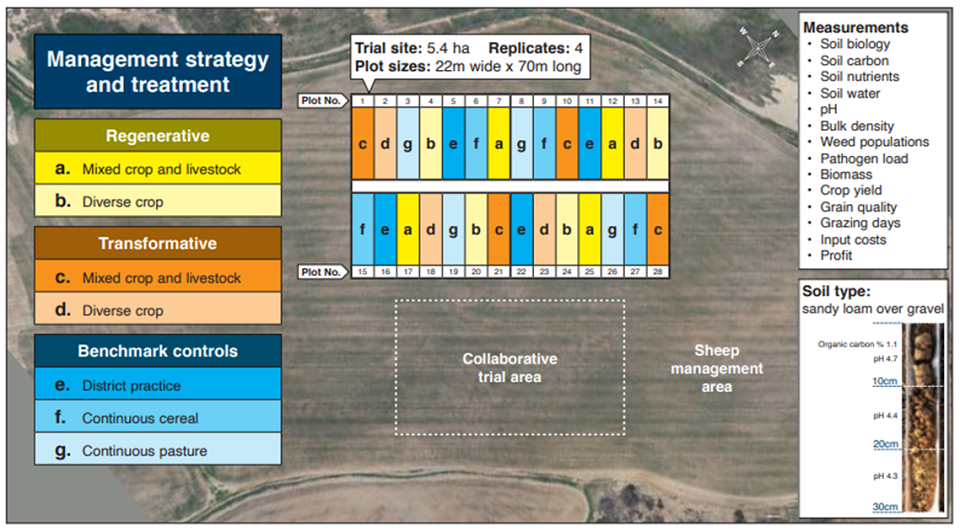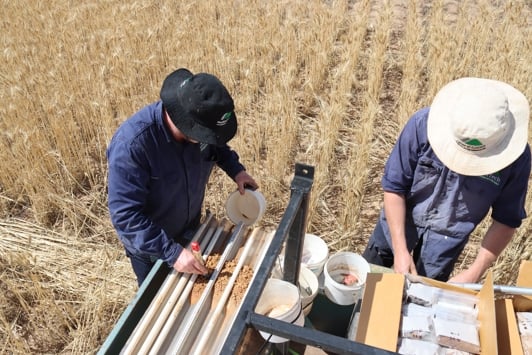What is the Future Systems Research program?
The Future Systems Research program is evaluating the long-term productivity, profitability and sustainability of different approaches to building climate resilience in low rainfall grain and mixed crop/livestock production systems.
Ongoing farming systems innovation is vital to the long-term resilience and evolution of farm businesses in the Eastern Wheatbelt in the face of climate change, increased cost structures, regulatory requirements and changing consumer preferences.
The research program is centred around the Climate Resilient Farming Systems Learning Hub established in 2020 at the Merredin Dryland Research Institute. The purpose of the Learning Hub is to co-locate farming systems research to enhance climate resilience in WA agriculture. It presents an opportunity for other projects and researchers to showcase new and innovative farming systems research, such as agtech solutions, or value add to existing established activities.
The Learning Hub also provides a space for engagement and extension of research to the wider farming community, industry stakeholders, researchers and students throughout primary, secondary and tertiary education.
Find out more about the research at the Merredin Dryland Research Institute
Learn moreThe key activity within the Learning Hub is a long-term, large-scale farming systems trial. The large-scale trial will run for 10 years, investigating seven alternative farming system approaches. Additional small plot trials to investigate focused research questions to increase understanding of interactions within each system are also being conducted.

Approaches to resilience
Growers utilise many different approaches to build farming system resilience. Approaches used are influenced by personal preferences, drivers and target outcomes. The systems being investigated in the long-term farming system trial and the key principles captured are:
Regenerative
These systems are focused on building soil health through practices targeting soil carbon, organic matter and microbial activity increase; reduced reliance on synthetic inputs and increased diversity of plant species grown, both between seasons and through the use of mixed species within any given season. Both mixed crop and livestock and cropping only regenerative systems are represented in the trial.
Agtech
This system is focused on early adoption of new innovations such as crop genetics, soil amelioration practices, agronomic advances and measuring and monitoring technology to support decision making. This system aims to create rapid change to maximise profitability and enhance soil productivity and system resilience. Both mixed crop and livestock and cropping only agtech systems are represented in the trial.
District practice
Guided by the research program’s reference group this system represents local best practice for productive, profitable and sustainable management, incorporating incremental adaptation and is driven by seasonal conditions and risk management.
Permanent pasture
Self-regenerating annual and perennial legume pasture system aiming to create the highest potential of soil carbon sequestration over the 10-year trial period and provide a scientific benchmark.
Continuous cereal cropping
Designed for minimal diversity, this system provides a monoculture benchmark in contrast to the permanent pasture.
Small plot trials in the Learning Hub focus on individual principles of the various systems have been established to investigate the benefits, feasibility and challenges of incorporating these principles in low rainfall, eastern wheatbelt farming systems.
Some of the additional small plot research trials at Merredin are:
- Biostimulant trial – looking at the effect on soil and plant growth of different bio-amendments.
- Summer active and perennial species – assessing the viability of a range of perennial and summer active crops and pastures in the Eastern Wheatbelt.
- Soil re-engineering – removing soil constraints by incorporating lime and using mechanical soil amelioration.
Measuring change
The long-term trial site underwent intensive soil sampling during its establishment to provide a baseline of soil properties including soil nutrients, physical characteristics, carbon levels and soil biology. These properties will be measured repeatedly over the life of the trial to monitor the change to soil properties under different system options over time.
Key metrics being monitored within the trial over the course of the 10-year period include:
- nutrient and water use efficiency
- soil carbon and organic matter
- soil microbial activity
- soil quality including soil nutrients, pH, bulk density, water storage and infiltration
- grain yield and grain quality
- pasture biomass and feed quality
- weed and disease burden
- insect pest and predator populations
- nutrient density of produce
- profit.
The department's economists and modellers will also conduct analysis of each system and assess systems under various modelled environment scenarios.
Reference group
Research program activities and strategic direction is guided by a reference group comprised of farmers, agricultural consultants, industry representatives and department scientists from a range of disciplines. The reference group provides input, advice and guidance on trial management decisions including system rotations, inputs and implementation of specific system principles relevant to the local environment and key areas for further investigation within the Learning Hub.
Soil biology and bio-amendments
In depth measurement and analysis of the soil biology in the long-term trial representative systems is identifying the soil microbial community present over time, and changes in microbial community or differences between seasons and management conditions represented across treatments. The investigations are refining which indicators and/or measurement methods are most effective in understanding soil biology on farm.
This knowledge will help in understanding how to integrate soil biology as a driver of decision making within farming systems in addition to soil physical and chemical characteristics. Specific measurements and the primary methodology used include:
- soil pathogens and beneficials (Predicta B)
- soil microbial biomass carbon and nitrogen (chloroform fumigation extraction method)
- microbial biodiversity and function (metagenomics sequencing)
- soil enzymes (dehydrogenase, chitinase and acid phosphatase using colorimetric assays)
- soil respiration
- microbial catabolic diversity.
To complement this soil biology work, the program is also investigating the use of bio-amendments in wheatbelt farming systems and their influence on soil quality, including soil biology, crop growth and production.
This involves both field and glasshouse experiments screening various classes of bio-amendments including commercially available products and farmer mixtures. This work will provide an evidence base for the purported claims of bio-stimulants and bio-amendments and enhance understanding of their contribution in achieving specific resilience outcomes within a farming systems context.

